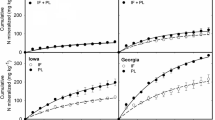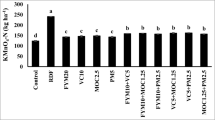Summary
Considerable effort has been spent in developing chemical indices to predict N mineralization. However, in spite of numerous studies, the relationship between the index value and plant N uptake has not been as apparent as hoped, and therefore, additional work is required to evaluate the ability of promising new indices to predict the extraction of mineralizable N from soil. The objective of the present study was to evaluate the use of phosphate borate and hot KCl to extract immobilized 15N-labeled fertilizer, applied 1 and 2 years previously. Soil samples (0–15 cm) were collected on 12 June 1989 from field soil fertilized in either 1987 or 1988 with 15N-labeled urea. In the laboratory, net N mineralization over 51 days and the amount of N extracted by the phosphate borate and hot KCl methods were determined. In the field, the amount of residual fertilizer and soil plus fixed N in soybeans (Glycine max) at the V5 growth stage were determined on 12 June 1989. The extractability ratio (ER*) and the mineralizable extractability ratio (MER) were higher for mineralizable N and phosphate borate N for fertilizer applied in 1988 than 1987, while ER* and MER values for the hot KCl were similar for both application dates. These results suggest that compositional changes occurred which influenced the extractability and mineralization of residual fertilizer applied 1 and 2 years previously, and that the phosphate borate was able to predict these changes while the hot KCl method was not.
Similar content being viewed by others
References
Allen AL, Stevenson FJ, Kurtz LT (1973) Chemical distribution of residual fertilizer nitrogen in soil as revealed by nitrogen-15 studies. J Environ Qual 2:120–124
Bremner JM, Mulvaney CS (1982) Nitrogen-total. In: Page AL, Miller RH, Keeney DR (eds) Methods of soil analysis, part 2, 2nd edn. Am Soc Agron, Madison, Wisconsin, pp 595–624
Clay DE, Malzer GL (1993) Tillage effects on soybean utilization of 15N labeled residual fertilizer. Soil Till Res (in press)
Clay DE, Clapp CE, Molina JAE, Dowdy RH (1990a) Influence of nitrogen fertilization, tillage, and residue management on a soil nitrogen mineralization index. Commun Soil Sci Plant Anal 21:323–335
Clay DE, Malzer GL, Anderson JL (1990b) Tillage and dicyandiamide influence on nitrogen fertilizer immobilization, remineralization, and utilization by maize. Biol Fertil Soil 9:220–225
Doran JW (1987) Microbial biomass and mineralizable nitrogen distributions in no-tillage and plowed soils. Biol Fertil Soils 5:68–75
Edwards AP (1978) A guide to the use of 14N and 15N in environmental research. Cold Regions Research and Engineering Laboratory Spec Rep 78-18, US Army Corps of Engineers, Hanover, New Hampshire
Felipo MT, Garau MA (1987) Comparison of biological and chemical methods to determine available nitrogen in sewage sludge amended soil. Biol Fertil Soils 5:26–30
Gianello C, Bremner JM (1986) Comparison of chemical methods of assessing potentially available organic nitrogen in soil. Commun Soil Sci Plant Anal 17:215–236
Gianello C, Bremner JM (1988) A rapid steam distillation method of assessing potentially available organic nitrogen in soil. Commun Soil Sci Plant Anal 19:1551–1568
He XT, Stevenson FJ (1989) Revised formulas for calculating extractability ratios of immobilized N in soil. Soil Biol Biochem 21:465–467
Hong SD, Fox RH, Piekielek WP (1990) Field evaluation of several chemical indexes of soil nitrogen availability. Plant and Soil 123:83–88
Juma NG, Paul EA (1984) Mineralizable soil nitrogen: Amounts and extractability ratios. Soil Sci Soc Am J 48:76–80
Keeney DR (1982) Nitrogen-availability indices. In: Page AL, Miller RH, Keeney DR (eds) Methods of soil analysis, part 2, 2nd edn. Am Soc Agron, Madison, Wisconsin, pp 711–733
Kelly KR, Stevenson FJ (1985) Characterization and extractability of immobilized 15N from soil organic matter. Soil Biol Biochem 17:517–523
Smith JJ, Stanford G (1971) Evaluation of a chemical index of soil nitrogen availability. Soil Sci 111:228–232
Stanford G, Smith JJ (1976) Estimating potentially mineralizable soil nitrogen from a chemical index of soil nitrogen availability. Soil Sci 111:71–76
Author information
Authors and Affiliations
Rights and permissions
About this article
Cite this article
Clay, D.E., Malzer, G.L. Comparison of two chemical methods for extracting residual N fertilizer. Biol Fertil Soils 15, 179–184 (1993). https://doi.org/10.1007/BF00361608
Received:
Issue Date:
DOI: https://doi.org/10.1007/BF00361608




